Jerusalem’s Jewish Quarter is located in the Old City of the capital of Israel, and it is one of the four districts of the Old City. The Jewish Quarter hosts almost two thousand Jews with a total extension of 0.1 square kilometres. In this district, there are many yeshivas, which are Torah schools for men, and ancient synagogues.

Many museums, synagogues, and the Western Wall are inside the beautiful Jewish Quarter. There is always something to discover, walking through the narrow alleyways and observing its inhabitants’ everyday life.
The Western Wall – The Wailing Wall
The Western Wall, which is well-known as Wailing Wall and Kotel, is the main attraction of the Jewish Quarter and the whole Old City of Jerusalem. The Kotel is the holiest place in Judaism, and it is the remaining part of the courtyard wall, which encircled the Second Temple.
The Wailing Wall dates back to the Herodian period, and it is the most visited place by Jews coming from all over the world. The Kotel is open for everyone who wants to stand in front of it and write a note, request or prayer on paper and put it in one of the several cracks of the Western Wall. There is a dress code for both women and men consisting of some rules such as dressing modestly and for men covering the head.
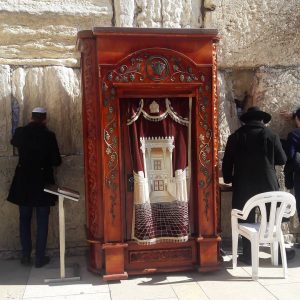
The Western Wall is a unique and stunning historical remnant, which is only a tiny portion of the majestic Second Temple complex. The Western Wall extends underground through the Wailing Wall Tunnels and the Small Western Wall, which is in the Muslim Quarter.
Landmarks Of The Jewish Quarter in Jerusalem
The Hurva Synagogue
The Hurva Synagogue is one of the most important landmarks of the Jewish Quarter and, in general, of the Old City of Jerusalem. In the 18th century, it was built, and it was destroyed a few years afterwards its construction.
In 1864, the Hurva Synagogue was restored and named Beis Yaakov Synagogue, becoming the main Ashkenazi synagogue of Jerusalem. The term Ashkenazim in Judaism refers to Jews coming from Medieval communities of Central and Eastern Europe.
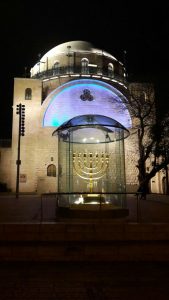
In 1948 the Hurva Synagogue went destroyed by the Arab legion, and in 1967 there was a plan to reconstruct this precious synagogue as soon as Israel controlled the Jewish Quarter again.
In 2000 the reconstruction began, and in 2010 the Hurva Synagogue was restored entirely anew, and nowadays, it is a stunning jewel in the Old City. It is worth visiting this synagogue, which is featured by a giant dome, making it a totally unique site.
The Cardo
The Cardo was the main road of Jerusalem since the Roman period. It starts at the Damascus Gate in the Muslim Quarter, and it extends until the Zion Gate in the Jewish Quarter. The portion of the Cardo in the Jewish Quarter dates back to the Byzantine period, and it has been well restored with the original stores that nowadays became souvenir shops. There are also many café and eateries in this area, and it is a fantastic place to have a walk.

The Herodian Quarter
The Herodian Quarter – The Wohl Museum Of Archaeology is a fabulous underground museum where tourists can see the actual streets that date back to the Herodian era. The Wohl Museum is a six-house complex that has been inhabited by aristocratic families and Cohanim families, who were the Temple Priests. Along the slope of the hill descending to the Temple Mount, there is a row of typical ancient houses. Underground there is the current street level of the Old City, and it is possible to get the impression about the ancient life at the time of the Second Temple in Jerusalem.
The Burnt House
The Burnt House is an impressive museum that is underneath the streets of Jerusalem, in the foundation of the residence of the Katros family, who lived there almost two thousand years ago. The house was burnt during the destruction and hence the burning of Jerusalem by the Romans in the first century. In the Burnt House, there is an interesting audio-visual presentation about the history of this house, providing a comprehension of the daily life in Jerusalem dating back to two thousand years ago.
Touring Around The Jewish Quarter of Jerusalem’s Old City
There are organised tourist tours to visit the Jewish Quarter in the Old City of Jerusalem. Nevertheless, tourists and visitors, in general, can organise a pleasant independent journey starting from Jaffa Gate, which is directed towards the old city of Jaffa and is the main entrance to the Old City.
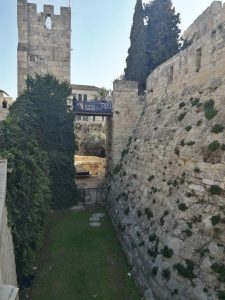
The Arabs named this gate “Bab al Khalil”, which means “the gate of Hebron” because from there, the road points to the city of Hebron. Once inside the Old City, on the right, there is the entrance to the Tower of David, which is one of the towers built by Herod and is named after his friend’s name, who was the commander of the Jerusalem army. It hosts exhibitions on the history of Jerusalem.
The Synagogue of Ohr Hachaim
At this point, it is possible to proceed to pass through a narrow street with the Kishla prison on the right side. After almost a five minute walk, it is recommended to turn on the left onto James Street and from there on to Or HaChaim Street. In the centre of the street, there is the Museum of the Old Yishuv Yard, and on the top floor, there is the Synagogue of Ohr Hachaim, where the holy Ohr Hachaim lived and built the synagogue. There is the Ha’ari Synagogue on the first floor, where Ha’ari Hakadosh was born and lived with his parents until his exile to Egypt.
Starting from Ha’ari Synagogue, it is recommended to walk to Chabad Street to find the Tzemach Tzedek Synagogue. In agreement with the Chabad community, the synagogue was built in the Old City and is open all day.
The Sephardic Synagogues And The Rabban Yochanan ben Zakai Synagogue
Close to the Ha’ari Synagogue, the Sephardic synagogues are part of a complex of four synagogues. These Sephardic synagogues were constructed on the lower level of the street during the Ottoman empire.
The first synagogue is the synagogue in honour of Rabban Yochanan ben Zakai, who established the Sanhedrin in the old city of Yavneh after the destruction of the Second Temple. According to the Jewish tradition, this synagogue was the place of his Beit Midrash, a learning community. And nowadays, in the Rabban Yochanan ben Zakai Synagogue, the appointed rabbi is Rabbi Rishon Lezion, who is the chief Sephardic Rabbi of Israel. The Yochanan Ben Zakai Synagogue holds two Holy Arks, one for the Torah scrolls and one for other holy books. Another unique feature of this mysterious synagogue is that anciently it had an ancient oil jar and Shofar, which were stored inside a glass shelf in the southern wall’s window. A Jewish tradition tells that these two ancient relics were original remnants of the Temple, which could only be used to proclaim the arrival of the Messiah. Another theory is the one by Abraham Moses Luncz, who in the 19th-century suggested that the oil jug was held in the synagogue only for being used in the ritual of Shituf Mevo’ot. The original relics disappeared after the synagogue’s destruction in 1948.
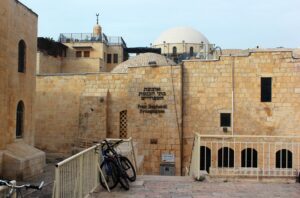
Close to the Yochanan Ben Zakai Synagogue, another synagogue is the Prophet Elijah Synagogue. The name of this synagogue was given because of an ancient tradition: one year on Yom Kippur, one person was missing for the minyan, which is a quorum of ten men needed to begin the prayers, and suddenly, a man appeared miraculously and completed the minyan. Afterwards, the man disappeared as soon as the fast day ended and the prayer as well. Thus the religious men who were praying realised that that mysterious man was Elijah the prophet.
The Middle Synagogue
The Middle Synagogue is in the Jewish Quarter of Jerusalem’s Old City. The courtyard common to the three synagogues was the women’s section, and additionally, on Sukkot, a sukkah was built by the worshippers in this courtyard.
The Kahal Zion Synagogue
Nevertheless, as soon as the Spanish community arose, it was determined to build a synagogue in place of this common courtyard. Hence, it became the Middle Synagogue or Cal El Medio, in Ladino, which is also well-known as the Kahal Zion Synagogue. After the return of the Ashkenazi community in Jerusalem with the Vilna Gaon students, the Sephardic community conceded them to pray in this area on Shabbat and holidays until they obtained government permission to have their own Torah scroll.
The Istanbuli Synagogue
Close to the Kahal Zion Synagogue, the Istanbul Synagogue was built in the Istanbul architectural style featuring marble windows decorated with stained glass, which surround the dome of the building, illuminating the synagogue splendidly. The dome of the synagogue rests on four marble pillars. After the Six-Day War, during the synagogue’s reconstruction, an ark from a synagogue of Ancona and another one from a synagogue of Pesaro, Italy, were placed in it. Nowadays, there are two minyanim: one is Sephardic and the other one Portuguese.
The Batei Machse Neighbourhood
Close to the Istanbuli Synagogue, the Shelter House Square has a magnificent structure built by the Kolel Ho”d, Jews who immigrated from Holland and Germany, providing a refuge for poor people on Mount Zion. There is the Breslev Synagogue in the courtyard, and behind the building, there is a gravestone in memory of 48 warriors killed and buried here. The bodies were removed after the Six-Day War and were buried on the Mount of Olives.
The history of the neighbourhood “Batei Machse” begun when in the first half of the 19th century, Jews were granted permission to build for the first time a Jewish area of their own. Several wealthy people chose to live in this neighbourhood, building their houses; an example is the magnificent “Rothschild House”.
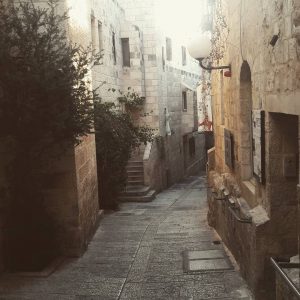
The Jewish Quarter is enriched with ancient history and hidden treasures besides the many well-renowned synagogues and museums, not forgetting the Western Wall! Many historical sites of the Jewish Quarter are very worth a visit, and there is always something new to discover! Indeed it is an unmissable landmark of Jerusalem.

